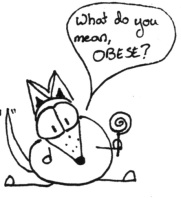Welcome to McCurdy Animal Hospital’s new blog! As always, our goal is to provide outstanding veterinary care for your pet. Knowledge is power, and we want to spread ours to help you in making educated health care choices for your pet. If you have any suggestions for a topic you’d like us to cover, please email Dr. Shelby Agnew at dra@mahvet.org. We’d also be happy to answer any additional questions during our normal business hours. With that, onto our first topic of the year, a timely one for January with New Year’s resolutions to lose weight and eat better still going strong – pet obesity.
 New studies show that 54% of our pets in the U.S. are overweight or obese. You read that right – OVER HALF of American dogs and cats have excess weight, which means they are at an increased risk for arthritis, diabetes, heart disease, and breathing problems. With such troubling statistics, what’s a dog to do?
New studies show that 54% of our pets in the U.S. are overweight or obese. You read that right – OVER HALF of American dogs and cats have excess weight, which means they are at an increased risk for arthritis, diabetes, heart disease, and breathing problems. With such troubling statistics, what’s a dog to do?
Body Condition Score
The first step is to determine if your dog or cat is indeed, overweight. Since pets come in all shapes and sizes, we use body condition scores (BCS) to help us determine whether Fluffy is carrying a few extra pounds. The best way to do this is with a doctor during an appointment for a weight and nutritional consult, but the basics are as follows:
- Feel the ribs. While you shouldn’t be able to see the ribs, you should be able to feel them easily without having to push too deeply.
- Find that waist. Both dogs and cats should have a slight “hourglass” appearance when viewed from above, with a narrowing between the chest and hips.
- Tuck it up. Pets should also have something called an “abdominal tuck.” This means that when viewed from the side, their tummy should go up a bit from the chest instead of hanging down.
Blood Work
Just like humans, pets can have hormonal abnormalities that increase their risk of obesity. We screen for these abnormalities with yearly blood work during our preventive care appointments. However, if you’ve noticed that your pet’s weight has made a sudden change (up OR down), go ahead and make an appointment; sudden weight changes can be a sign of a serious disease.
Diet
Once we’ve determined that your pet is overweight and otherwise healthy, it’s time to start losing those pounds before they start causing serious problems. Once again, just like humans, diet and exercise are the mainstays of good health. Although there is no “one size fits all” for diets, the basics remain the same.
The first and most important steps is to take all people food and treats out of your pet’s diet. That means no table scraps, no bits of cheese, and no licking the plate after you finish dinner. What you perceive as “just a bite” can be the equivalent of 2 or 3 extra cheeseburgers! The same goes for treats, many of which are high in fat and calories. If you have questions about a particular favorite, just give us a call.
Many dogs can lose weight with some simple lifestyle changes, but some require changing to a prescription or low calorie food. Before embarking on a diet change, give us a call to discuss the best food for your pet.
Exercise
The good thing here is that exercise recommendations for dogs by and large match those for humans – 30 minutes a day, 5 days a week, the same as is recommended by the American Heart Society. So get those tennis shoes out and start walking! In addition to the weight loss, exercise can help strengthen muscles and help decrease arthritis pain.
Unfortunately, it’s the rare cat that walks well on a leash and overweight cats can be less interested in moving about. Encouraging exercise in your feline friend has to be a little more creative! Start with short play times of 5-10 minutes, 3 or 4 times throughout the day, using lasers, feather toys, or balls to keep your kitty on the move. In addition, feeding small meals throughout the day, especially feeding on top of a cat tree, can help increase your cat’s exercise AND wellbeing!
